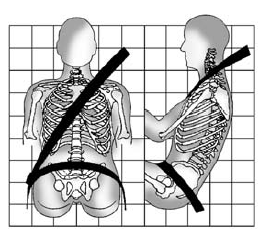Chevrolet Spark Owners Manual: How to Wear Safety Belts Properly
This section is only for people of adult size.
There are special things to know about safety belts and children. And there are different rules for smaller children and infants. If a child will be riding in the vehicle, see Older Children on page 3-32 or Infants and Young Children on page 3-34.
Follow those rules for everyone's protection.
It is very important for all occupants to buckle up. Statistics show that unbelted people are hurt more often in crashes than those who are wearing safety belts.
There are important things to know about wearing a safety belt properly.

- Sit up straight and always keep your feet on the floor in front of you.
- Always use the correct buckle for your seating position.
- Wear the lap part of the belt low and snug on the hips, just touching the thighs. In a crash, this applies force to the strong pelvic bones and you would be less likely to slide under the lap belt. If you slid under it, the belt would apply force on your abdomen. This could cause serious or even fatal injuries.
- Wear the shoulder belt over the shoulder and across the chest.
These parts of the body are best able to take belt restraining forces. The shoulder belt locks if there is a sudden stop or crash.
Warning
You can be seriously injured, or even killed, by not wearing your safety belt properly.
- Never allow the lap or shoulder belt to become loose or twisted.
- Never wear the shoulder belt under both arms or behind your back.
- Never route the lap or shoulder belt over an armrest.
 Safety Belts
Safety Belts
This section of the manual describes how to use safety belts properly. It also
describes some things not to do with safety belts.
Warning
Do not let anyone ride where a safety belt cannot be worn ...
 Lap-Shoulder Belt
Lap-Shoulder Belt
All seating positions in the vehicle have a lap-shoulder belt.
The following instructions explain how to wear a lap-shoulder belt properly.
Adjust the seat, if the seat is adjustable, so you can ...
Other materials:
Engine Oil Pressure Light
Caution
Lack of proper engine oil maintenance can damage the engine. Driving
with the engine oil low can also damage the engine. The repairs would not be covered
by the vehicle warranty.
Check the oil level as soon as possible. Add oil if required, but if the oil
level is within the operatin ...
Starting the Engine
Automatic Transmission
Move the shift lever to P (Park) or N (Neutral). The engine will not start in
any other position. To restart the engine when the vehicle is already moving, use
N (Neutral) only.
Caution
Do not try to shift to P (Park) if the vehicle is moving. If you
do, you could dam ...
OnStar Additional Information
Transferring Service
Press to request account transfer
eligibility information. The Advisor can assist in canceling or removing account
information.
Selling/Transferring the Vehicle
Call 1-888-4-ONSTAR immediately to terminate your OnStar services if the vehicle
is disposed of, sold, trans ...
